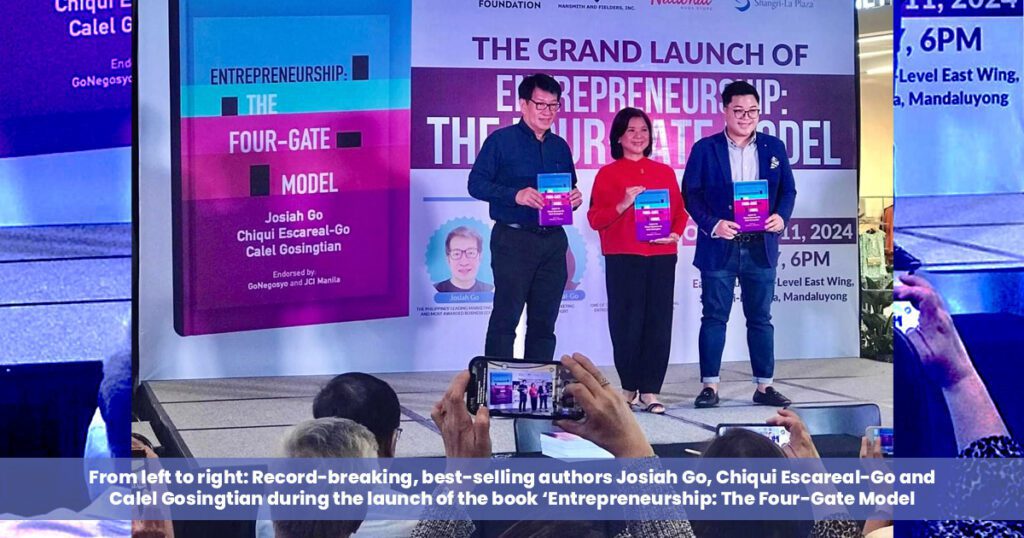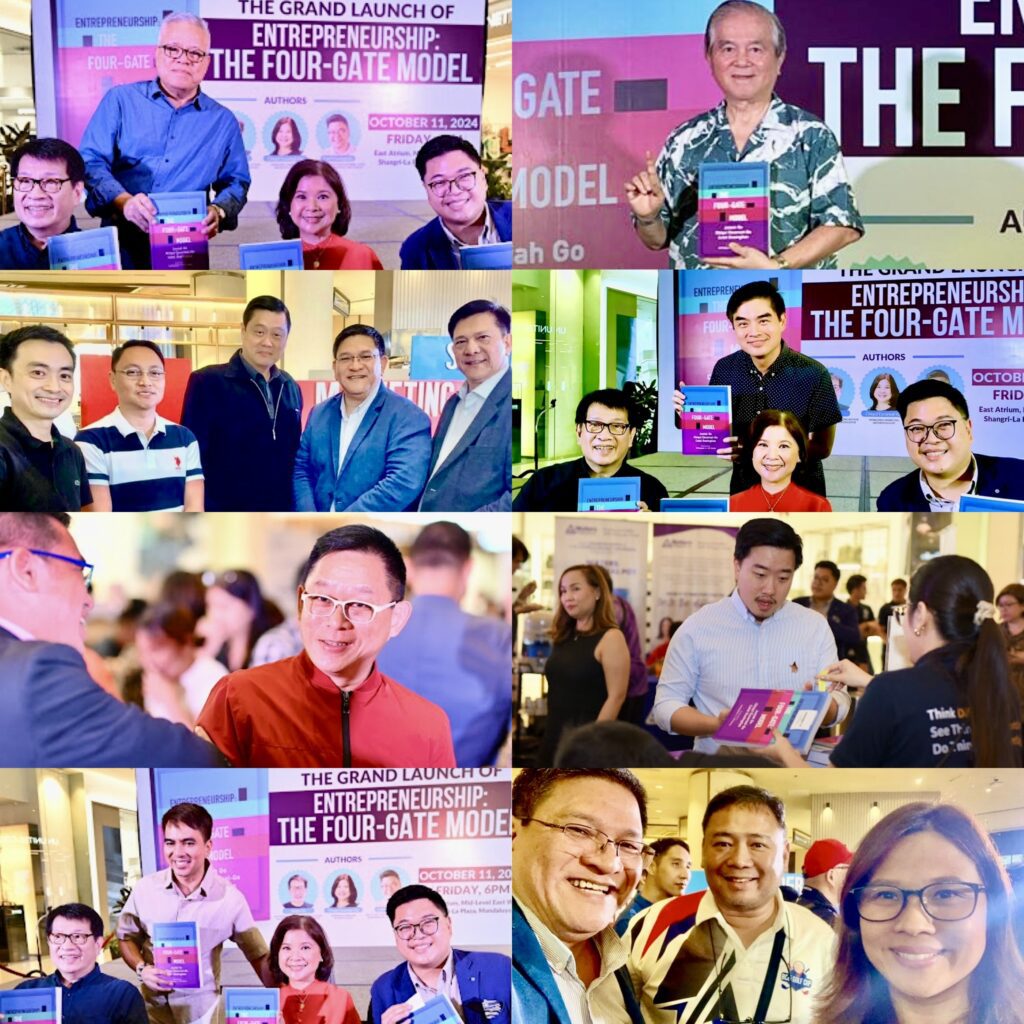
Decades ago, the metrics of success for a business book launch were relatively simple. Selling 200 copies in a single night was considered an achievement. We did a quick mental calculation and figured that in a two-hour window, the author had to sell 1.66 books per minute, or roughly 1 book every 36 seconds. In the past, the key activities at a launch included writing dedications, signing the books, and taking photos with each guest who attended.
Times have changed. On October 11, 2024, we launched the book Entrepreneurship: The Four-Gate Model, co-authored by myself, anthropologist Chiqui Escareal-Go, and JCI Manila president Calel Gosingtian. Our goal was to redefine what a successful book launch could look like in the modern era. We were fortunate to have the entire mid-level of the East Wing of Shangri-La Mall in Mandaluyong as our venue—an upgrade from our usual location inside National Book Store. We wanted to use this opportunity not just to launch a book but to create a transformative experience that would resonate with attendees and set a new benchmark in the industry.

4-Step Process to Innovation
To achieve this, we applied the Mansmith 4-step process for game-changing innovation: challenging the status quo, identifying pain points, brainstorming strategic solutions, and ultimately aligning our approach with an evolved business model. This approach enabled us to pivot quickly and continuously refine our strategies until we got it right.
Step 1: Challenging Assumptions
The practice of innovation begins by questioning the long-held beliefs that dominate any industry. The traditional approach to book launches has often been formulaic, emphasizing author-centric activities like speeches, book signings, and discussions about the book’s content. We chose to challenge these assumptions and redefine the event’s focus. Here are five core assumptions we confronted:

- Book launches are solely about the authors and the book. We asked ourselves: What if the event could focus on marginalized public school readers who don’t have access to books and their journey, as well as the entrepreneurial community we are building through shared learning?
- Book signings are the main attraction. While signings are a valuable part of the experience, we realized they could also be a bottleneck that hinders the event’s flow.
- Success is measured by the personal presence of guests. Traditionally, the number of guests present physically at the event was a key metric. We broadened our scope to consider digital engagement and the ripple effect of our launch on social media.
- Book launches end when the event concludes. We challenged the notion that the event’s impact should be limited to the day itself, aiming for sustained engagement with our readers long after the launch.
- Readers primarily want the authors to talk about the book’s content. We shifted the focus to providing actionable insights and real-world applications of the book’s concepts, empowering readers to implement the Four-Gate Model in their own entrepreneurial journeys.
This mindset shift allowed us to see the book launch not as a standalone event but as the start of a continuous learning experience.
Step 2: Pain Hunting
No innovation is complete without a clear understanding of the pain points and barriers that could hinder success. We took a hard look at the challenges that typically accompany book launches, especially on a Friday night in Manila, where traffic, unpredictable weather, and competing social commitments can discourage attendance.
Some specific pain points we identified included:

- Guests not showing up due to logistical issues. Even the most loyal followers might have been deterred by the difficulties of navigating Manila’s notorious traffic on a Friday evening.
- Payment delays at the cashier counter. Traditional cash or card transactions can create long lines, leading to frustration and lost sales opportunities.
- Long lines for book signing. While it’s a special moment for attendees to get a personalized dedication, the waiting time can dampen the overall experience.
- Time spent taking photos with the author. While these moments are cherished, they can slow down the event’s momentum if not managed well.
Understanding these pain points allowed us to think differently about how to not only address them but turn them into opportunities to deliver a superior experience.
Step 3: Strategic Brainstorming
Addressing these challenges required a fresh perspective and a willingness to experiment. Here’s how we reimagined the book launch experience through strategic brainstorming:

- Pre-booking and #Buy1Give1 Initiative: We introduced an innovative campaign that allowed readers to pre-book their copies and participate in our #Buy1Give1 initiative for public school students. This initiative enabled those who couldn’t attend the launch to support the cause by buying books in bulk and in advance, then sharing them with friends, partners, suppliers, franchisees, and dealers, most of them our non-customers. In effect, our market-driving strategy not only expanded our reach but also fostered a sense of community and collaboration around the importance of literacy. The collective efforts amplified the impact of the book even before the event took place, demonstrating the power of shared purpose and collective action.
- Direct Pre-Payment to Streamline Transactions: To minimize wait times during the event, we offered a pre-payment option, allowing guests to quickly pick up their books upon arrival without queuing at the cashier.
- Pre-signed Books with Flexible Options: Authors pre-signed a big batch of books to give guests the choice of either taking a pre-signed copy immediately or joining the line for a personalized dedication. This flexibility catered to different market segments—both those who valued efficiency, and those eager to engage personally with the authors.
- Convenient Delivery Options: We offered buyers the flexibility to either pick up their pre-signed copies at the launch or have them delivered to their homes, providing convenience that fit their preferences.
- Community Photo Opportunities: Before the book signing began, we set up the Entrep4Gates backdrop so attendees could take photos either with the authors or alongside friends. This arrangement allowed people to capture memorable moments without waiting in long lines for individual photos. And instead of individual photos, we encouraged groups of friends to take collective photos with the authors. This not only sped up the photo-taking process but also fostered a sense of shared experience and community.
- Post-launch Learning Support: To keep the momentum going, we developed post-launch initiatives such as an Entrep Rescue Q&A (scheduled on December 14, 2024, 9-12nn), a study group (scheduled on January 8, 15, 22, 29, 2025, 3-5pm), and an Entrep4Gates Summit (in 2025). These programs were designed to deepen the engagement with readers, turning the book’s concepts into practical strategies that could be applied to their businesses.
Step 4: Evolving or Aligning the Business Model
Perhaps the most significant transformation came in how we aligned the business model of the book launch with our broader goals of community building and sustained engagement.

- Investing in Brand Loyalty: While the average cost per person of the food exceeded the retail price of a single book, we focused on enhancing our business model by encouraging volume purchases. This approach allowed us to provide a memorable experience without compromising on the quality of hospitality. The decision to invest in high-quality food, including the iconic lechon, was deliberate. We viewed this as an investment in brand loyalty and community building, creating an atmosphere of celebration that made our guests feel valued and appreciated. This gesture was more than just a meal; it was a statement of gratitude to our supporters and a way to foster deeper connections.
- Creating a Narrative Beyond the Book: We strategically shifted the focus of the narrative in our communications. Instead of merely summarizing the book’s content, we added behind-the-scenes insights into the thought process that led to the creation of the Four-Gate Model. This approach generated curiosity and anticipation, transforming the launch into a story that people wanted to share with others.
- Sustainable Engagement: By turning the book launch into an experience that extended beyond a single evening, we aimed to create a ripple effect. Our initiatives were designed to keep readers engaged, learning, and sharing their insights long after the event, thereby maximizing the book’s influence in both their personal and professional lives.

The Result
The outcome of our efforts exceeded our expectations. We set a new benchmark by achieving sales that were over eleven times the old norm, breaking National Book Store’s 82-year history with the highest-ever sales quantity during a business book launch. Remarkably, the book became the number one entrepreneurship book, the number one business book, and the number one non-fiction book in the month of launch, despite being available mostly in only the book launch store and launching just five days before the bookstore’s cutoff. More importantly, we went beyond our promise by donating over 5,000 books to public school students across seven schools, more than doubling our initial commitment.

This achievement wasn’t just about the numbers; it was a testament to the power of challenging assumptions and embracing innovation. By redefining what a book launch could be, we turned it into a catalyst for community-building, learning, and sustained engagement.
Key Takeaways
The key lessons in the book launch are:

- Innovation is a Continuous Process: Innovation doesn’t stop with the creation of a product or service. It extends to how we create and deliver value, engage with our audience, and create experiences that resonate.
- Think Beyond the Transaction: A book launch is more than just a sales event. It’s an opportunity to build relationships, foster loyalty, and create lasting memories that turn attendees into advocates.
- Engage the Community: Our success was rooted in our ability to engage not just those who attended but also those who couldn’t be physically present. Market-driving initiatives like #Buy1Give1 allowed us to expand our normal reach and impact.
- Create Value Beyond the Product: By offering post-launch learning support, we demonstrated our commitment to our readers’ growth, turning the book into a living, breathing entity that evolves with its audience.
A heartfelt thank you to everyone who supported this journey—from our readers, fellow entrepreneurs, and friends, to our #Buy1Give1 donors, and the incredible team that made this milestone possible. This is the power of innovating not just in what we offer but in how we deliver it to those we want to serve.

***
Josiah Go is the chair and chief innovation strategist of Mansmith and Fielders Inc. He facilitates Game-Changing Innovation, as well as Business Model Innovation workshops for the corporate market.
The book Entrepreneurship: The Four-Gate Model (by Josiah Go, Chiqui Escareal-Go, and Calel Gosingtian) is the 2024 best-selling entrepreneurship book. Get the book for FREE when you join the 9th Mansmith Entrep Summit: The Four-Gate Model on November 8, 2025. To learn more, visit: bit.ly/9thEntrepSummit.



